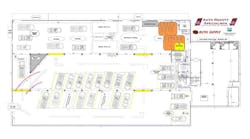Today’s high-tech ignition control systems do the same job the old, cam-driven contact points accomplished, but more efficiently and with less regular maintenance. Revised and upgraded ignition spark and fuel control systems were made necessary by clean air regulations and fuel-economy requirements.
Changes have occurred at a rapid pace so ignition systems in service bays today come in various forms:
- Traditional distributor ignition
- Distributorless ignition systems
- Coil-on-plug
- Ion-sensing systems
In addition, advances in engine controls continue to emerge, challenging service professionals to constantly stay updated as new technologies are introduced to the market.
The traditional system
Simple distributor ignition system designs have been quite consistent over the years, but specific components have been tailored to each engine and function. Most problems result from poor maintenance of the worn parts or an incorrect application. A distributor ignition includes a battery, the primary resistor or loom resistor and the ignition coil.
The battery is designed to offer all the energy required to operate the distributor ignition system. In a 12-volt system, normal readings are 12 volts with key on engine off, and 13 to 15 volts with the engine running and the generator charging.
The system is designed as a series circuit with special resistance values assigned to each component to allow all voltage to be consumed with proper current flow.
The primary resistor or loom resistor is placed between the battery supplying voltage and the ignition coil. The primary ballast resistor, or loom resistor wire, provides a calibrated 6-volt drop. Voltage drop also increases when voltage increases because of charging system activity, thus keeping the coil supplied with a steady 6 volts. Combined with the working primary winding resistance of the ignition coil, this allows a normal point life of about 20,000 miles.
Newer electronic systems do not use this dropping resistor so supply voltage is equal to battery voltage at all times. This change alone raises the actual current flow throughout the system. While 3 to 4 amps of primary current was the norm for an older system, today’s systems may run as much as 10 to 12 amps. Also, the time required to build the coil secondary charge has decreased from an average of 10 to 12 milliseconds in a typical 1970 application to as low as 1 millisecond or less for a vehicle made today.
The ignition coil serves as a basic transformer. In a points system, it boosts the primary-circuit low voltage (6 to 8 volts) into a much higher secondary voltage (5,000 to 30,000 volts). The primary ignition coil winding has a low resistance — typically 1 to 3 ohms — that again drops the 6-volt primary supply voltage to approximately zero.
The secondary windings, which are 100 to 200 times the primary windings, transform the current in the primary windings into the secondary when the primary switch is opened. This causes the magnetic field in the primary side of the coil to collapse and cut across the secondary windings, inducing the secondary current.
Coils are designed with different “turn ratios.” Turn ratios are the number of secondary windings versus the number of primary windings. A coil with a given turn ratio might make an engine easier to start, but not capable of delivering enough current at high rpm. As a result, coils are designed as a compromise.
Each coil is designed to provide the correct spark current and proper duration of spark to ignite the air/fuel mixture in the combustion chamber.
Today’s coils
Many advances have been incorporated in today’s ignition coils. A multibobbin wound coil using laminated steel “e-core” is a design now commonly used by many OEMs. This winding arrangement increases the magnetic induction of the coil, creating a greater secondary current with a much smaller coil. They’re typically used in coil-on-plug systems that have a coil at each cylinder. The coil is mounted directly on the spark plug, therefore eliminating the secondary cables on earlier systems. Coil-on-plugs only fire each coil when its cylinder fires, therefore using much less energy than older, single-coil systems. A single cylinder also can be shut down when needed, like in the event of a misfire.
Multistrike coil-on-plug systems also are used as an emissions clean-up device. These units can fire the spark plug two to three times in the amount of time the older systems fired the plug once.
Switching ignition system controls
From the most basic cam-driven contact points system to electronic control module and powertrain control module electronic controls, all ignition systems basically do the same thing. Some just do it better than others.
The old-style contacts worked very well for many years but required periodic maintenance and adjustment. A typical set of cam-driven points was adjusted to a gap of 0.017 inch using a feeler gauge with the contacts sitting on the cam high point. These contacts arced on opening, so a condenser was incorporated in the circuit to help minimize the arc. A useful life of approximately 20,000 miles was the norm when all system parts were correctly adjusted and matched for design-spec voltage drop.
Federal regulations mandated that all emissions-related systems must run 50,000 miles unattended. These specifications required the development of the electronic switching circuits. The newer, lean air/fuel mixtures also required an increased spark firing time (duration), demanding greater spark current.
By using an electronic control module, the overall primary circuit resistance can be decreased, greatly reducing the time required to reach maximum current levels. A 2.6-ohm resistance primary circuit allows a coil to charge in 10 milliseconds while a 0.5-ohm resistance primary circuit lets a coil charge in 3.4 milliseconds. This decrease in charge time makes it possible for a coil to reach full current at higher engine speeds. Today’s electronic systems are able to supply 35,000 volts above 3,000 engine rpm, while with the old, conventional systems current usually would drop at engine speeds above 1,000 rpm.
Any engine still using a cam-driven distributor shaft even if only used as a cam position sensor should be considered a traditional engine. Although many “traditional” distributor ignition systems are in service today, most manufacturers are using newer designs.
Distributorless ignition systems
In a distributorless ignition system, a spark plug is connected to each end of an ignition coil secondary winding. Each coil fires two cylinders at once: one on compression (with fuel/air) and the other on exhaust (burnt mixture). One plug will fire in a forward direction, center electrode to ground, while its companion will fire in reverse. Slightly more energy is needed to fire the cylinder on compression.
On traditional distributor ignition systems, the primary current was limited to 3 to 5 amps, which allowed the coil to produce approximately 20,000 to 30,000 volts. On a common distributorless ignition system, the primary coil resistance may be as low as 0.5 ohm and regulating current is needed to prevent primary current from exceeding approximately 8.5 to 10 amps. Ignition output could easily be 50,000 to 60,000 volts on these systems.
General Motors, for example, shows specifications of 3.8 amps for a traditional distributor; 5.5 amps for a high energy ignition electronic distributor; and 8.5 to 10 amps for distributorless ignition systems in their SD 105 manuals. This is pretty typical of most OEMs over the last few years. Again, lower primary resistance equals increased current.
Coil-on-plug
The coil-on-plug system has an ignition coil individually mounted above each cylinder. Some systems still use a short secondary ignition cable, while many others use a spring connector with no cable at all.
Some are controlled and fired directly by the powertrain control module while others — those with the coil near the plug as just described — have a control module built into the coil. The coils/modules are then fired sequentially, so the coil has a very short event cycle. This keeps the coil cooler than a common coil. Firing time and duration, along with timing decisions, are made by the powertrain control module, which triggers each coil/module individually.
Coil-on-plug systems supply very high ignition energy for plug firing. Because the ignition wires are shorter or non-existent, less energy is lost to ignition wire resistance. No energy is lost to the resistance of a waste spark system like in the distributorless ignition arrangement.
Ion gap systems
Delphi’s ionization-current-sensing ignition system uses a single coil per cylinder with no high-voltage leads. The spark plugs in these applications are used not only to ignite air/fuel mixtures, but are combined with a detection strategy that enables the electronic or powertrain control module to monitor the entire combustion process.
Ion-current sensing is based on the use of a positive, low-voltage direct current bias applied to the spark plug during the combustion process. Measuring this current after it sparks provides an indication of the actual conditions of the combustion event, and all information is calculated using signal decoding. Once processed, this signal can then be used to control misfire, knock, cylinder synchronization and, on some vehicles, the actual air/fuel mixture.
Different applications employ variations on this system. A 2004 Saab, for example, uses no primary bank-one oxygen sensor, while ion-sensing Saturns have no cam sensor.
These newer systems have almost made the conventional ignition scope outdated. The secondary hookups aren’t readily accessible, and in some cases, even the primary hookups are hard to find. So how do technicians analyze these systems?
First of all, complete knowledge of the system and how it works is a must. The Delphi system’s specifications give us some vital service information. It shows that the unit is expected to have spark duration of 1.5 milliseconds, a secondary resistance of 3,200 ohms, primary resistance of 0.25 ohms, charge (or ramp) time of 2.3 milliseconds and an expected current build up of 11.25/13.25 amps. Armed with this information, it’s possible to test each value for expected results and determine the component causing the failure.
For this, a technician needs knowledge of the system and circuit being tested, a good lab scope and low-current probe.
More information can be found at www.google.com and www.delphiauto.com, using the keyword “ionization.”
Low-current probe testing
The use of a low-current probe makes ignition testing of these units quick and very easy to perform. The low-current probe is simply placed around a primary ignition system voltage supply wire (or fuse) and will show all effects of the entire ignition system from this non-intrusive hookup.
Care must be taken to prevent exposing the probe to underhood interference. If feasible, hooking up the probe at the fuse panel is always preferred to prevent stray signals from inducing false readings.
What should be expected when observing current draw? Figure 4, from a 1994 Ford training booklet, shows the coil action very well. Not only is the rise time of the ignition coil magnetic field controlled, but the current allowed in the coil is controlled as well.
For example, on most early Ford Thick Film Ignition (TFI) systems, these values are set at 3.6 milliseconds of rise time (coil charging) and 5.5/6.5 amps, depending on the control module being used. Knowing these values allows the service technician to see a damaged ignition part very easily with a low-current probe and a scope. See Figure 5 for a known good example.
Now, to apply this to a vehicle for service, we had a Ford TFI car that came in from another shop with the customer complaint of “the car eats ignition parts.” After years of servicing these and other ignition problems, the answer is always the same for this complaint.
First, a visual inspection would show that nearly all ignition parts have been replaced with new ones, and some more than once. The engine does run, but it is very hard to start.
If a vehicle “eats” or “burns up” ignition parts, the cause is always excessive heat, which results from a resistance problem. Low resistance equals high current; high current equals excessive heat and, subsequently, failed parts. This may not be the entire story, but the answer and thought pattern to derive it is always the same.
A scope and low-current probe are used to observe the “current ramp.” In other words, look at the current signal, coil build-up and current limits as set by the ignition control module. But before deciding what the values found indicate, it’s necessary to know what the values of a normally functioning vehicle with TFI should look like. (See the figures, left, for a prior, good-running test.) The current probe is set for 100 mV = 1 amp.
Looking closely at this current waveform, we now know that the rise time of the coil is 3.6 milliseconds and the current limit — the flat part of the waveform — is exactly 5.44 amps. This is a known good TFI Ford product specification; every unit we have tested similar to this looks the same.
The coil is turned on (left of waveform) and the grounded coil allows, or accepts, a charge that lasts for exactly 3.6 milliseconds. Then the current is limited by the ignition control module to approximately 5.5 amps as designed.
Now knowing what to expect, let’s look at our problem vehicle just for comparison. Although a different scope was used to test our broken vehicle, it’s easy to see that there is not a correct rise time. In addition, current is poorly limited, if at all. Not only is the waveform erratic, it comes and goes with the engine running. This is a “control” problem, and the new replacement ignition module is determined to be faulty.
A new module restored the correct rise time and current limit to the car, which now starts very well and no more parts are needed.
Is “current ramping” a procedure technicians can use to analyze cars? Of course. Some people call the use of a current probe and lab scope unreliable, but most will agree this is not true.
All that is needed is a basic knowledge of how the circuit works, a scope (or in some cases a graphing multimeter) and a good, low-current probe. By regularly performing tests using these tools, technicians can increase their circuit knowledge and learn what to expect with the various systems they see and test.



